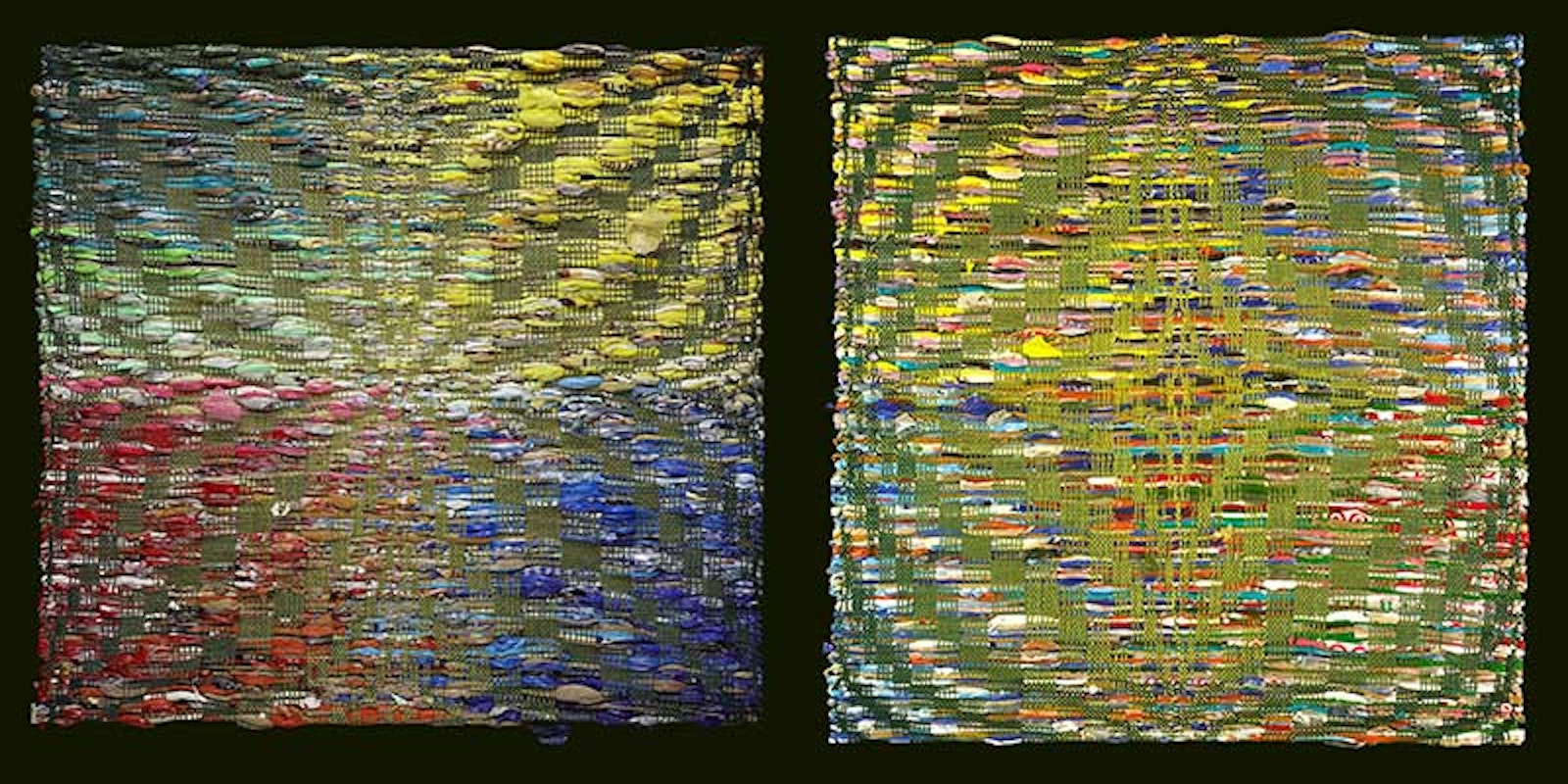Julie Kornblum’s and my weaving circles overlap only slightly in Southern California, but I have always admired her work. It is original and reflects her passion for eco-art. Julie incorporates recycled items into her work: plastic bags, bottle caps, old hub caps, and all kinds of other things most of us throw away. She is active in Yarn Bombing of Los Angeles (YBLA), California Fibers, Southern California Handweavers Guild, and Knerdy Knitters. She has been in countless exhibits and has won many awards for her work.
Recently, I asked Julie to respond to some questions about her weaving life and where she gets inspiration and to provide us with some photographs of some of her favorite pieces, Plastic in the Trees 1 and 2, and The Fifth Element. I also asked Julie to submit a piece for Handwoven January/February 2018, our Eco Yarn issue. (You are going to love what she wove for that!)
Weave well, Susan
Q: How and when did you start weaving?
A: I took my first fiber arts class at California State University Northridge in 1996.
Prior to weaving, were you creating other types of fiber or non-fiber art? Oh, yes. My grandmother taught me to crochet when I was 12. The following year in home economics, I learned to sew, and I continued to sew throughout junior high and high school.
Q: What was your first weaving project?
A: My first project was a very long colorful plaid scarf that I still have and wear every year on one of our two cold days in the winter here in California.
Julie Kornblum with The Fifth Element
Q: What do you love to weave and why?
A:Twill and overshot are my favorite weave structures. When I was looking for ideas to start my second weaving project, I fell in love with the twill and overshot patterns I saw in weaving books. The assignment was a pattern weave. Marguerite Porter Davison’s A Handweaver’s Pattern Book was my favorite book then, and it still is today.
Q: Where do you find inspiration? When you start planning a project, where do you begin?
A: Usually something in everyday life will spark an idea. Plastic in the Trees came from literally seeing plastic bags caught in trees as I was going about my day. Once I have an idea, I decide on a pattern structure and color palette that supports the concept. For example, for Plastic in the Trees, I chose a Blooming Leaf overshot pattern and used a gradation of greens.
Friends and acquaintances can be helpful with inspiration, too. People are only too happy to give me materials they would otherwise throw in the trash. Sometimes they give me something I didn’t know I was looking for, and the materials themselves give me ideas.
Part of learning is making mistakes. What is your biggest weaving disaster, and what did you learn from it? One time, I forgot to tie the cross in my warp. I didn’t realize it until it was too late. I spread the warp out across the back beam but then realized there was nowhere to slip in the lease sticks. I had to scrap that warp and wind a new one. Fortunately, I had enough extra yarn.
Q: Do you have a favorite project or one you’re the most proud of?
A: The Fifth Element and my two Plastic in the Trees pieces are my favorites, and they have also been my most successful in exhibitions, and at winning awards. As I was creating them, the concepts came together and I felt the materials and colors I chose related to and supported the underlying meaning of the pieces. I really enjoyed the design challenge and the execution of both projects.
The Fifth Element by Julie Kornblum: photo credit: Julie Kornblum
Q: Whom do you admire in the weaving community?
A: So, so, so many people: almost every weaver I know, for different reasons. The people who weave with silk and fine threads—wow; the people who dye their own yarn and do amazing things with their color palettes—wow. Everyone does amazing things.
Q: What is your favorite tip to make weaving easier or more efficient?
A: I write out reminders so I don’t have to rely on my memory to keep track of where I am in the pattern and project overall. I write or print out my pattern horizontally so I can pin it on my loom, right in front of my face.
Q: What advice do you have for new weavers?
A: We all make mistakes. When you show your work to someone, don’t point out your mistakes.



